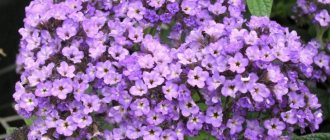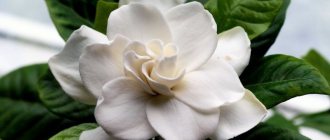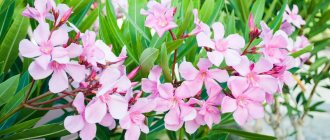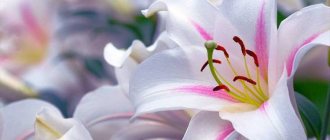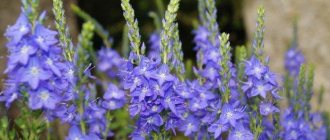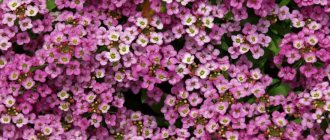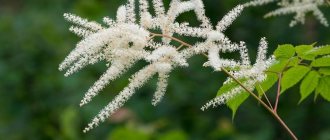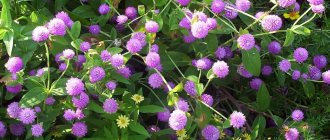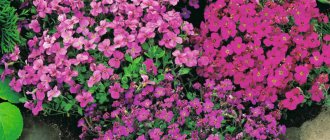There are many varieties on the flower market that are not planted in gardens of temperate latitudes. But instead of a garden, planting it at home is quite possible. Such crops include the nerine flower, from the Amaryllis family.
Author of the article
Maxim Sverchkov
Professional biologist and breeder with extensive experience and experience.
This family contains many exotic and very beautiful flowers. Although the plant is capricious and requires care, it is still worth trying to plant this flower.
Nerine is grown in gardens with warm climates, because the plant’s homeland is South Africa. When grown indoors, in summer you can take it out into the garden. Externally, the nerine flower looks very impressive: thin, elongated and curled petals, long linear leaves and a delicate aroma. This exotic beauty blooms for two months.
Popular varieties and types of nerine with photos, planting, cultivation and care, reproduction
Among the numerous Amaryllis family there is an unusual flower - nerine. The plant owes its romantic name to the mythical nymph – Nereis.
This representative of the flora has several other names - spider lily and African lily.
The content of the article:
1. Description of the plant 2. Varieties of flowers of nerine 2.1 Nerine Bowden 2.2 Nerine bashful 2.3 Nerine sarney 2.4 Nerine angustifolia 2.5 Nerine sinuous 2.6 Nerine Hutton 2.7 Nerine low 3. Planting and care in open ground 4. Methods of propagation of nerine 4.1 Reproduction by tubers 4.2 Reproduction seeds 5 How to care in open ground 6. Nerine pests 7. Planting and care at home
What diseases and pests can you suffer from and how to fight them?
Nerine rarely suffers from diseases and pests. However, the plant is not immune from bulb rotting. To prevent this from happening, it is recommended to control watering.
Often, however, the flower may suffer from attacks by aphids. In this case, you should immediately treat the plant with special chemicals. If after the first treatment the pests have not disappeared, the procedure should be repeated after a few days.
Bowden's nerine is a perennial flower. It is cold-resistant, that is, Nerine Bowden feels good in open ground.
The plant bulb is mostly located above the soil. There can be from six to twelve flowers on one stem.
Additional information about the characteristics of the plant and recommendations for its cultivation can be found in the video:
Nerine - description of the plant
The plant is a perennial
and has a bulbous root system. On the long stem of the peduncle, an inflorescence is formed in the form of a basket, on which 5-20 buds bloom. The height of the peduncle can reach 50 cm.
Photo of Nerine flower
Nerine foliage has a structure characteristic of most lily plants - narrow ribbon-like leaf plates of a dark green color.
The inflorescences form a pleasant, original sight - delicate outwardly curved petals and long stamens in the center of the flower. The color of the buds can be white, scarlet, pink, orange or crimson. The funnel-shaped bud is 4-5 cm in diameter.
Description of Nerine - video
Varieties of Nerine flowers
In the world, according to various sources, there are from 10 to 30 species of nerine, including plants grown indoors.
Types of Nerine:
- Bowden;
- bashful;
- Sarney;
- narrow-leaved;
- tortuous;
- Hutton;
- wavy;
- low.
Nerine Bowden
The most famous and popular species is Bowden's nerine.
Brief review of Nerine Bowden - video
This species is easier to grow in the garden due to its resistance to cold.
The bulbous tuber reaches 5 cm in diameter.
Often forms children around itself. Often, children, growing in size, are able to exist independently. A beautiful inflorescence contains 6-12 buds that look like a delicate flowing bell with dissected petals. Bowden's nerine flowers have a delicate scent. The time for flowering begins in October.
Nerine bowdenii has an elongated tuber. The length of the belt-shaped leaves is 30 cm with a width of 25 mm. The height of the peduncle is 45 cm. The curved petals are often painted in lilac tones.
Nerine the bashful
The shy spider lily is a valuable ornamental plant.
There are very few buds in the inflorescence of shy nerina (5-6).
The petals are drooping, which explains the romantic name of the species. Blooms white.
Nerine pudica is endowed with a rounded tuber, the diameter of which is only 3 cm. The foliage is belt-shaped, green in color with a silvery tint.
Nerine sarney
Nerine sarney has a rich color palette. This species was used as a base for breeding hybrid varieties.
Nerine angustifolia
Nerine angustifolia is almost devoid of foliage, but is distinguished by a long peduncle.
Inflorescences with curled petals with wavy edges are colored pink and lilac.
Nerine winding
The African lily is a rare specimen, with delicate and frilly petals of white or pink flowers.
Nerine Hatton
This lily is endowed with narrow green foliage and small pink inflorescences, which create a picture of abundant blooms due to a significant number of flowers.
Nerine wavy
The African wavy lily differs from other species in its straight foliage and peduncles,
on which 8-10 red or pink buds bloom.
Nerine low
The low lily develops a peduncle and foliage at the same time.
One peduncle of low nerine can contain about 20 buds of red or pink color with pointed petals. The height of the plant is only 30 cm.
Popular varieties of Nerine low:
- Rushmere Star
with bright pink petals and black anther; - Blanchefleur
with white delicate petals and stamens; - Lyndhurst Salmon
is a muted pink color with a longitudinal stripe down the center of the petal.
Types of plants and their features
In nature, there are several varieties of flower culture. Common ones include the following.
Nerine Sarneyskaya
The progenitor species of many hybrids. It features red, white and orange flowers. The petals are narrow, curled at the top of the stems.
Nerine Twisty
Rare view. The flowers are represented by inflorescences of light bells, which are located at the ends of elongated stems. Flowering period is autumn.
Nerine the Shy
The bulb is round, 3 cm in diameter. Leaves from four to six, color bluish-greenish. There can be from four to six flowers on one stem;
Nerine Bent Leaf
Brought to Europe from Cape Verde. The leaves of the flower are ribbon-linear and appear completely only after the flower has faded. The flowers are large and look like lilies. Color – red.
There are many hybrid species, but the most notable is Bowden's Nerine. The cold-resistant and strong plant is much less whimsical than its counterparts.
Nerine: planting and care in open ground
From the second name of nerine, the place of origin becomes clear. This is the continent of South Africa. The homeland of this bulbous plant determines the basic care requirements.
Nerine care - video
A place for bulbous plants is selected in a sunny, elevated position. Nerina needs diffused sunlight. Excess moisture and draft winds are harmful to it.
The composition of the soil should be loose with the addition of sand. The content of peat, humus or compost is welcome.
Provided the soil has a clay structure, a drainage layer is created. This measure will protect the bulb from rotting.
Reproduction by baby bulbs
How to plant nerine bulbs photo
It is most convenient to propagate by daughter bulbs during spring transplantation.
Nerine bulbs photo
Carefully separate the young bulbs from the main one and plant them one at a time in separate pots with soil, as for adult plants.
Planted nerine bulbs photo
Select small pots, leaving only 2-3 cm in diameter around the bulb: this trick allows you to force the plant to bloom, and not waste energy on producing baby bulbs.
Nerine propagation methods
There are two effective ways to propagate African lilies - seed and bulbous.
Reproduction of nerine by tubers
There will be no difficulties with the bulbous propagation method for nerine. It is necessary to remove the baby bulbs growing around the mother tuber from the soil and lightly dry them in the fresh air. After some time, nerine is planted in open ground. In this case, the bulb is not completely immersed in the soil, but only so that the upper part of the tuber is exposed to air. The planting is moistened and covered with mulch.
Photo of Nerine propagation by tubers
Nerine breeds in mid-summer or early August.
It is necessary that the tuber has time to gain strength and take root normally before October. The first flowering may occur this year, but it will be scanty.
Nerine - propagation by seeds
To use the method of propagating nerine by seeds, you will need to be patient. And nerine will bloom only 3 years after sowing the seeds.
Photo of propagation of nerine by seeds
Nerine seeds mixed with dry sand are sown in a container with fertile soil. Experienced gardeners use vermiculite for these purposes. After sowing and moistening, the container is covered with glass and placed on a lighted windowsill. The ambient temperature should be within +22C.
The glass is periodically removed for ventilation. The first shoots should appear on days 15-18, after which the glass is removed. The third leaf that appears is a signal that it is time to plant the seedlings. At the same time, the ambient temperature can be reduced by +5C, as well as the quality of natural light. Then the plants are grown for 3 years, without providing them with a rest period.
GOOD VARIETIES OF FLOWERS!
Park rose Louis Audier Rose Decor Harlequin Rose Frederic Mistral
In open ground, nerine can be grown with almost no problems. It can easily withstand low temperatures down to -12C.
In cold regions, the bulbs are removed from the soil with an earthen lump and sent for storage in a cold place. In spring the plant returns to the garden.
Important!
The African lily has two dormant periods per year – winter and summer. In winter, baby bulbs are laid, and in summer, the lily gains strength to bloom.
As a place for winter storage of tubers, you can consider a glazed loggia or balcony, where the bulbs will be kept in a box with peat.
An alternative storage location is the bottom shelf of the refrigerator.
Growing Nerine from Seeds
Nerine seeds photo
Article on the topic: Photos of Yucca aloelia, ivory, filamentous, glaucous, glorious, lapel-leaved
Nerine is propagated by seed and daughter bulbs.
Seeds must be sown immediately after ripening. Use boxes or bowls filled with nutritious soil. The seeds are distributed over the surface of the soil and are not buried in the ground. The distance between the seeds is 2-3 cm. Spray the crops with a spray bottle. Vermiculite can be used as soil. Cover the crops with film and germinate at an air temperature of at least 22° C.
Nerine from seeds photo shoots
Expect germination in a couple of weeks. When 2-3 leaves appear, plant them in separate containers. Nerines obtained from seeds must be grown for 3 years without a dormant period.
How to care for nerine in open ground
During dormancy, the bulbs do not need watering
. When the plant blooms, it should be moistened carefully, avoiding stagnation of moisture. Nerine prefers diffused sunlight as lighting. Direct scorching rays will be destructive for the lily.
Photo of nerine in open ground
It is necessary to feed the nerine plant twice every 30 days.
Any complex compositions for flowering plants will be suitable. In this case, overly concentrated solutions should be avoided.
Important!
Since the flower comes from the tropics, it prefers moist air. It is recommended to organize gentle spraying.
BEAUTIFUL FLOWERS!
Weigela: photo, planting and care Hydrangea Gloxinia
Spider lily is planted in open ground at the end of July or beginning of August.
It is worth maintaining a distance of up to 7 cm between adjacent bulbs. The plant does not require any special care, the main thing is to remove weeds and moisten it during flowering.
It is not recommended to plant nerine in lowlands.
Landing rules
The bulbous crop can be planted in several pots. However, the diameter of the container chosen for growing should not be less than 12-14 centimeters. Some gardeners prefer to root nerine in even larger pots, planting the plant in a circle, with the crops 3-4 centimeters apart from each other. In this option, the flower will not produce offspring, but will actively bloom. The plant should be planted in the ground in such a way that part of the bulb remains on the surface.
The perennial requires loose and light soil with a slightly acidic environment. You can make such a soil mixture yourself by mixing sand, humus and turf soil in equal parts.
For proper development, the plant will need a drainage layer at the bottom of the pot.
Pests of Nerine
This attractive plant can be seriously damaged by mealybugs or aphids.
To prevent pest attacks, you can spray with a soap solution.
In difficult situations, special preparations against harmful insects are used. In most cases, Nerine is disease resistant. The plant can suffer from the wrong place in the garden or illiterate care.
Sometimes it can suffer from viral mosaic disease.
The African lily is attractive to local flower growers because its flowering time begins in October.
when other plants are already entering a dormant period.
Important!
Flower growers should be careful when caring for this lily, because its juice is poisonous. For this reason, you should keep this perennial away from children and pets, and wash your hands thoroughly after gardening.
This late-blooming perennial is a desirable resident of flower beds. Regions with mild climates and warm winters are suitable for growing outdoors. Where the climate is harsh, it is recommended to grow nerine indoors, and only keep it on a balcony, loggia or open veranda in the summer.
Virulence
When caring for this plant, it is important to be careful and very careful, since its juice is poisonous. Contact with it leads to burns of the skin and mucous membrane , which, as a rule, take a long time to heal.
Nerine juice also has a negative effect on pets. When caring for a flower, it is important to wear gloves and cover exposed areas of the hands and mucous membranes. After finishing work, be sure to wash your hands with soap.
Nerine: planting and care at home
It is recommended to awaken the bulbs before planting.
When kept indoors, in March the tubers are removed from their storage place (refrigerator), immersed in the ground and kept at +23-25C until the end of summer.
Once a bronze tint appears at the top of the tuber, it will be possible to judge that it is awakening and ready for planting. After this, it is worth replacing the soil with fresh one and moistening the planting. After 20-30 days, flower stalks should appear.
Up to 2 tubers can be planted in one flower container with a diameter of 13 cm.
There is another planting method, where a significant number of tubers are planted around the perimeter in one container, while leaving a small distance from each other (3 cm). African lily bulbs planted in this way will allow you to enjoy active flowering, but they will not reproduce in such close quarters.
Good to know!
The recommended soil composition is slightly acidic and loose. A drainage layer in a flower container is required.
Useful article:
How to improve the soil, its fertility, composition, structure
When the growing season begins, the plant should be provided with 12 days of light.
Watering at this time should be moderate. The top layer of soil in the flower pot should have time to dry completely. When flowering stops, the frequency of watering should be reduced, and after the above-ground part dies off, watering should be stopped completely.
During flowering, the plant needs support. Therefore, fertilizers should be applied every 14 days for amaryllis flora.
This extraordinary plant requires a little more attention due to its two dormant periods.
So, after flowering, it is necessary to remove dry leaves and store the tubers for storage. This is the first period of rest. Nerine’s second “vacation” occurs in May-August.
Care
Growing nerine requires certain skills. In order for the plant to feel good and bloom in a timely manner, you need to create favorable conditions for it.
Lighting
During the entire growing season, nerine needs bright, diffused light.
Temperature
In the summer, the flower is kept in a warm room, at a temperature of 23-25°C . During the winter dormant period, the container with the plant must be moved to a cool place, with a temperature of 8-10°C.
Humidity and watering
During active growth, the bulb requires a lot of moisture, but it needs to be watered frequently, but moderately. If watering is done incorrectly and the bulb is constantly in wet soil, it will rot and may die.
The maximum amount of moisture is required by the plant during the period of forcing flower stalks, which occurs in early autumn. When the nerine flowers, watering is gradually reduced and then stopped altogether, resuming it with the germination of the bulbs.
You can find out whether watering is correct by the condition of the leaves, if any . If the foliage turns yellow and withers at the wrong time, this indicates both an excess and a lack of moisture in the soil.
Despite the fact that nerine is a tropical plant, when grown indoors, it does not require high air humidity. Therefore, there is no need to place any trays of water next to the pot.
Top dressing
You can replenish your supply of nutrients using liquid fertilizers. During flowering, mineral fertilizers are used once a week, and after flowering and until the second half of spring, the bulb needs to be fed once every 14 days.
What is the name of the Japanese art of arranging bouquets?
OrigamiIkebana
Transfer
The rules for transplanting nerine are practically no different from transplanting other representatives of the amaryllis family. The pot does not need to be too large - practice shows that a container diameter of 10-13 cm is quite enough for a flower . If the pot is wider, this will be the main reason for the growth of nerine to stop. When transplanting a bulb, it does not need to be completely buried in the soil - 1/3 of the head should be left on the surface.
It is best to replant the flower in August, when the summer dormancy period begins. At this time, you should not frequently moisten the soil, and also carry out procedures to clean the leaves from dust and dirt.
The plant should be replanted as rarely as possible, as it does not like changes in environment. Experts recommend just changing the top layer of soil near the flower, and replanting it once every 4-5 years.
Priming
During transplantation, you can use store-bought amaryllis soil or make your own soil. To do this, take equal quantities of sand, turf soil and humus.
Rest period and forcing
The flower has two dormant periods, which occur in summer and winter. To prepare the plant for hibernation, you should cut off the dry tops, and also place the pot in a cool room with low humidity ( the air temperature should be no more than +10 degrees ). Nerine should be kept in this state until the beginning of spring, since then the buds will begin to actively form. In summer, the dormant period lasts much less - you can understand that the plant can be returned to its usual living conditions easily by the color and condition of the leaves, which will become brighter and healthier.
The plant needs to transition to an active state gradually. You cannot place a pot of bulbs directly on the window - you need to gradually increase the temperature in the room, make the light brighter, and also increase the frequency of watering.
Immediately after the bulb awakens, a bronze coating appears on it - this means that it can be planted in fresh soil, and also do not forget to water it.
